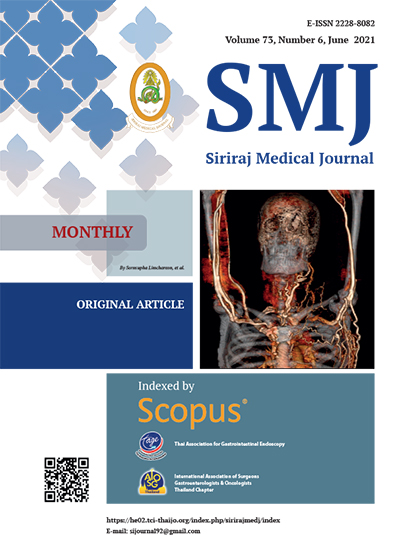G-control Charts for Contamination Rates of Blood Cultures in a University Hospital
DOI:
https://doi.org/10.33192/Smj.2021.54Keywords:
Hemoculture, Blood culture, Contamination, Rate, Geometric, SPC chartAbstract
Objective: To determine blood culture contamination rates, and display with a g-chart.
Materials and Methods: The medical records of patients, from whom blood cultures were obtained in a university hospital, during January and December 2019 were retrieved and reviewed for contamination. The Center for Disease Control and Prevention (CDC) criteria were used to classify the blood culture results. The contamination rates were illustrated with a g-chart.
Results: We identified 331 false-positive blood cultures, among 32,961 cultured specimens; yielding a contamination rate of 1.0% (95%CI = 0.9% – 1.1%). The highest contamination events occurred in the Emergency department (49.2%), Pediatric ICU (5.2%) and Neonatal ICU (4.8%), respectively. The most common commensal bacterial genus were Staphylococcus coagulase negative (67.1%), Bacillus spp. (10.2%) and Corynebacterium spp. (7.6%), correspondingly. The g-charts could identify 14 abnormal variations, in 41 locations.
Conclusion: The contamination rates found were within ranges of other reports. G-charts are simple to construct, easy to interpret and sensitive for detection of real time epidemics.
References
Hall KK, Lyman JA. Updated Review of Blood culture contamination. Clin Microbiol Infect 2006;19:788-802.
Alahmadi YM, Aldeyab MA, McElnay JC, Scott MG, Darwish Elhajji FW, Magee FA, et al. Clinical and economic impact of contaminated blood cultures within the hospital setting. J Hosp Infect 2011;77:233-6.
Goto M, Al-Hasan MN. Overall burden of bloodstream infection and nosocomial bloodstream infection in North America and Europe. Clin Microbiol Infect 2013;19: 501-9.
Lawless, J.F. Negative binomial and mixed Poisson regression. Can J Stat 1992;15: 209-25.
Miller JM, Binnicker MJ, Campbell S, Carroll KC, Chapin KC, Gilligan PH, et al. A guide to utilization of the microbiology laboratory for diagnosis of infectious diseases: 2018 updated by the Infectious Diseases Society of America and the American Society for Microbiology. Clin Infect Dis 2018;67:813-6.
CDC.gov [Internet]. Atlanta : NHSN Patient Safety Component Manual 2021; [cited 2021 March 1]. Available from: https://www.cdc.gov/ncidod/dh
Benneyan JC, Lloyd RC, Plsek PE. Statistical process control as a tool for research and healthcare improvement. Qual Saf Health Care 2003;12:458-64.
Lalezari A, Cohen MJ, Svinik O, Tel-Zer O, Sinvani S, Abed Al-Dayem Y, et al. A simplified blood culture sampling protocol for reducing contamination and costs: a randomized controlled trial. Clin Microbiol Infect 2020;26:470-74.
Yang Z, Xie M, Kuralmani V, Tsui KL. On the performance of geometric charts with estimated control limits. J Qual Technol 2002;34:448-58.
W K Luk. An outbreak of pseudobacteraemia caused by Burkholderia pickettii: the critical role of an epidemiological link. J Hosp Infect 1996;34:59-69.
Hashemizadeh Z, Bazargani A, Davarpanah MA. Blood Culture Contamination in a Neonatal Intensive Care Unit in Shiraz, Southwest-Central Iran. Med Princ Pract 2011; 20:133-6.
Chang C-J, Wu C-J, Hsu H-C, Wu C-H, Shih F-Y, Wang S-W, et al. Factors Associated with Blood Culture Contamination in the Emergency Department: Critical Illness, End-Stage Renal Disease, and Old Age. PLoS ONE [Internet]. 2015 Oct 8 [cited 2020 Jan 14];10(10). Available from: https://www.ncbi.nlm.nih.gov/pmc/articles/PMC4598129/
Washer LL, Chenoweth C, Kim H-W, Rogers MAM, Malani AN, Riddell J, et al. Blood culture contamination: a randomized trial evaluating the comparative effectiveness of 3 skin antiseptic interventions. Infect Control Hosp Epidemiol 2013; 34:15-21.
Self WH, Speroff T, Grijalva CG, McNaughton CD, Ashburn J, Liu D . Reducing Blood Culture Contamination in the Emergency Department: An Interrupted Time Series Quality Improvement Study. Acad Emerg Med 2013;20:89-97.
Jame C, Bennayan. Performance of Number-Between g- Type Statistical Control Charts for Monitoring Adverse Events. Health Care Management 2001;4:319336.
Published
How to Cite
Issue
Section
License
Authors who publish with this journal agree to the following conditions:
Copyright Transfer
In submitting a manuscript, the authors acknowledge that the work will become the copyrighted property of Siriraj Medical Journal upon publication.
License
Articles are licensed under a Creative Commons Attribution-NonCommercial-NoDerivatives 4.0 International License (CC BY-NC-ND 4.0). This license allows for the sharing of the work for non-commercial purposes with proper attribution to the authors and the journal. However, it does not permit modifications or the creation of derivative works.
Sharing and Access
Authors are encouraged to share their article on their personal or institutional websites and through other non-commercial platforms. Doing so can increase readership and citations.















